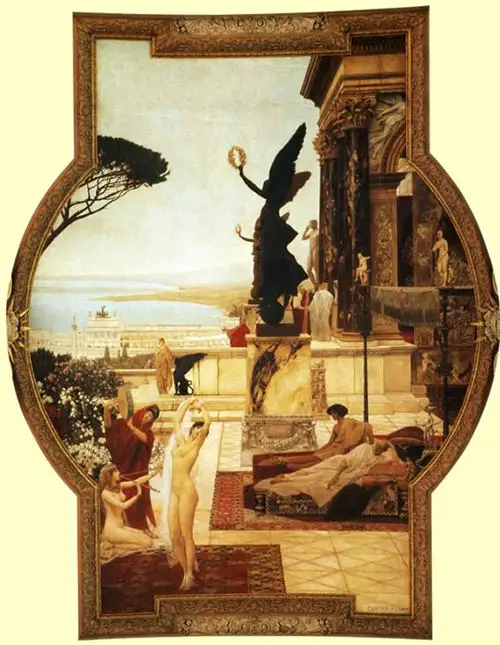 Buy Art Prints Now
Buy Art Prints Nowfrom Amazon
* As an Amazon Associate, and partner with Google Adsense and Ezoic, I earn from qualifying purchases.
The remarkable ceiling painting for the Burgtheatre of Vienna was painted by Gustav Klimt and two of his other colleagues for emperor Franz Joseph from 1886-1888
Theatre in Taormina is a beautiful artistry crafted with a multitude of design and technique showcasing the beautiful form of the culture.
The painting is based on the Ancient Greek lifestyle that the Emperor Franz Josef lived under. The lavish lifestyle is illustrated through the striking painting that showcases the prominent elements. As the mural was commissioned at the onset of Klimt's career, it is painted in a realism technique on looking to an impeccable multitude of detail.
The piece illustrates the ravishing lifestyle of the rulers of Greece during the 19th century. The focal point of the piece is the naked woman showcased in the centre of the canvas. The woman stands in an upright position on the tips of her toes, extending her body in an extravagant form illustrating her long stretch.
The woman folds her hands above her head in a circular position while her body moves to the tunes of the music in the background. Through her fingers the woman holds a sheer white fabric that sways behind her body as she dances.
To the left of the accelerating woman is another seated with her legs tucked beneath her. The woman plays an instrument for the emperor to which the woman dances.
The woman playing the instrument is accessorised in a large necklace that wraps her neck, while her body is naked in the sun. Behind the woman stands another musician, playing a large instrument clothed in a red fabric against her body.
The emperor is seated against a large chair, starring at the silky form of the woman dancing and swaying under the music. These two nude women dance for the emperor, gazing at their natural character. Gustav Klimt is prominently known for painting nude woman as their natural character is showcased through the movement of their bodies unravelled. The emperor is seated next to another woman, who watches the show unravel in the amusement of the head of the kingdom.
The viewer's attention is drawn to the background of the painting that illustrated a large black sculpture of an angel holding a gold crown of leaves. The marvellous sculpture is prompted on a marble base, engraved in a mosaic pattern of shapes. The painting is based in an outdoor garden, covered by lush fabrics and materials. The viewer is able to locate an array of patterns and colours that illuminate the work. Marble, granite, copper, gold, silver, black stone, and a multitude of other materials cover the area in wealth. This extraordinary diversity in mediums is also apparent in his Stocklet Frieze murals.
To the right of the piece, a glimpse of the Kingdom is showcased by flourishing pieces of stones engraved in different arrangement, decorating the walls in a grace and bloom. The wealth continues into the background of the piece, as the mural is elongated uncovering a deck that unfolds into a falling view. The light blue colours of Greece's ocean unfold in front of the viewer. The mountain blend into the horizon of the piece, covered in a musky layer of clouds.
The colour of the sky is left a snow white; to accentuate the colours within the mural rather than bringing attention to a dark blue that fills the sky. The mural is painted in the shape of a keyhole, as if the viewer is starring into the hidden lifestyle of the Greek emperor who lays in paradise. The classic symbol of Klimt is shown to the left of the piece, as rose bushes blossom uncovering the natural setting that is accustomed to the artist.




